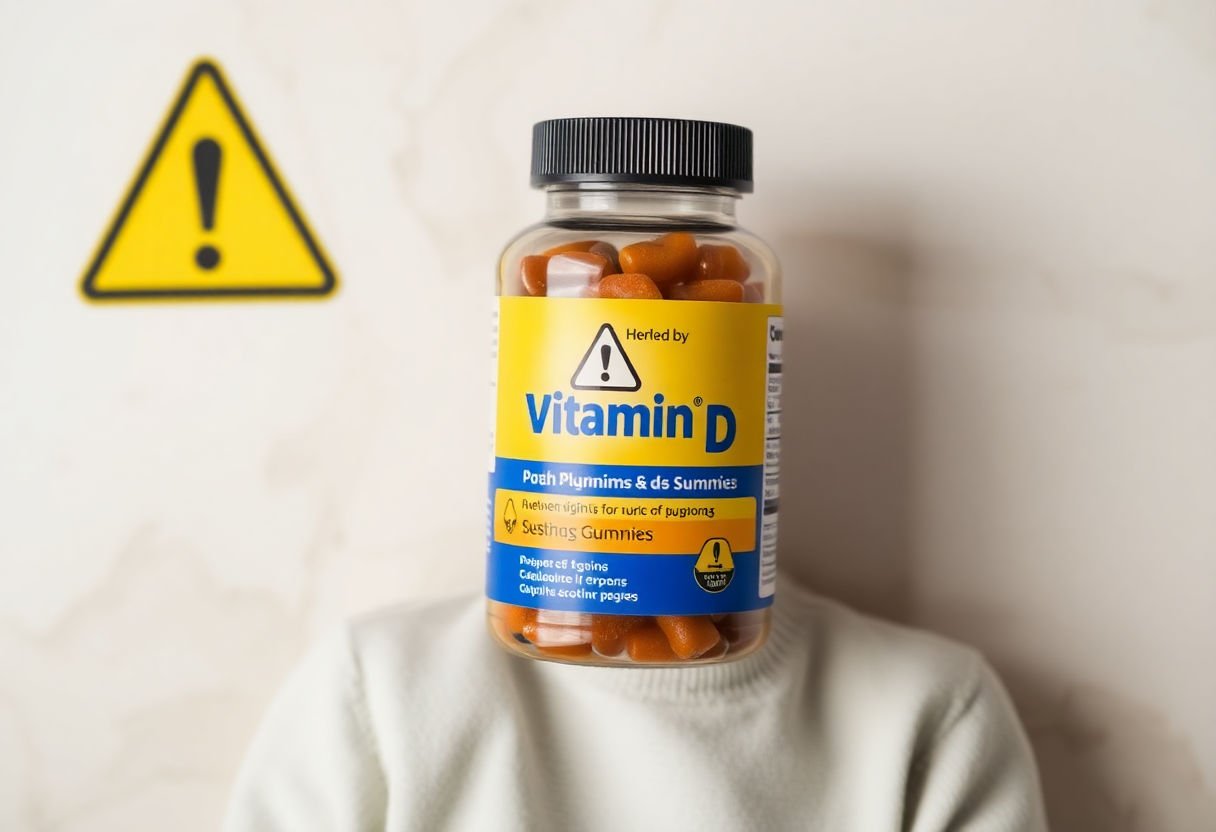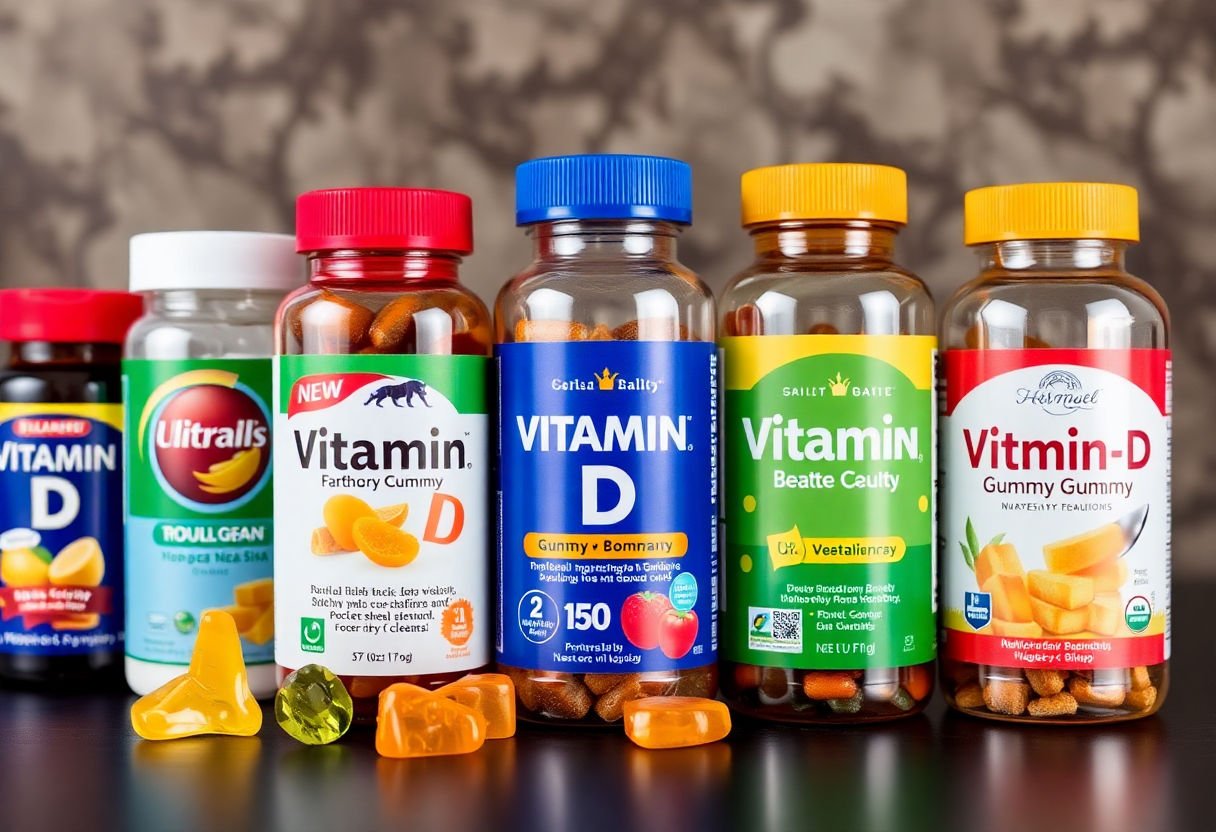Exploring the significance of vitamin D in fostering children’s health underscores its essential role in bone formation and immune support. As many children face dietary limitations, vitamin D gummies emerge as a kid-friendly supplement solution, offering a palatable and convenient option. This article delves into how these gummies not only appeal to younger tastes but also serve as an effective alternative to traditional pills. Beyond their flavor and form, they provide a promising avenue for ensuring adequate vitamin D intake, paving the way for parents to support their little ones’ overall growth and well-being seamlessly.
Key Takeaways
- Vitamin D is essential for children’s bone health and overall growth, playing a pivotal role in their immune system function.
- Gummies offer a palatable and convenient alternative to traditional vitamin D supplements, especially attractive for picky eaters and children with dietary constraints.
- When used correctly, vitamin D gummies are a safe addition to a child’s diet, with well-established dosage recommendations to follow.
- To avoid potential side effects, it is important for parents to adhere to guidelines and consult with healthcare professionals if needed.
- For optimal health benefits, parents should research and select high-quality vitamin D gummy brands tailored for children.
Understanding Vitamin D’s Role

Vitamin D plays a pivotal role in ensuring the healthy development of children. It is essential not only for the formation and maintenance of healthy bones and teeth but also for immune system fortification. This vitamin facilitates the absorption of calcium and phosphorus, which are critical for bone health, reducing the risk of fractures and deformities such as rickets.
Beyond its skeletal benefits, vitamin D also strengthens the immune system, helping children fend off infections more effectively. It enhances the pathogen-fighting effects of monocytes and macrophages, white blood cells that are important parts of the immune defense. Ensuring adequate vitamin D levels can assist in reducing the incidence of common childhood ailments, such as colds and flu.
Moreover, vitamin D is believed to influence mood regulation and cognitive function in children. Some studies suggest a correlation between adequate vitamin D levels and improved cognitive performance and mood stability, potentially mitigating issues like depression and anxiety.
Children’s growth and overall well-being depend significantly on maintaining optimal levels of vitamin D, especially during their formative years. Insufficient vitamin D can lead to delayed physical growth, fatigue, and increased susceptibility to chronic diseases. Therefore, recognizing and understanding the integral role of vitamin D ensures that parents can make informed decisions about their child’s health, such as considering convenient supplementation options like vitamin D gummies. These gummies not only provide an appealing means to ensure adequate intake but also support the diverse health requirements of growing children.
Why Gummies for Kids?
Gummy vitamins have revolutionized the way parents approach supplementation for children. Gummies for kids are particularly appealing due to several factors that make them preferable over traditional pill supplements.
First, the palatability of gummies is unmatched. Unlike pills or capsules, which can be difficult for children to swallow, gummies come in various flavors and shapes that are both enjoyable and engaging for kids. This increases the likelihood that children will remember to take their vitamins consistently, establishing a healthy routine.
Furthermore, these gummies often come with added benefits. They may include additional nutrients such as vitamin C or calcium, providing a comprehensive dietary supplement. This is particularly beneficial for children with dietary restrictions who may miss out on essential nutrients from food alone.
Additionally, the convenience factor plays a significant role. Gummies do not require water to swallow and can easily be packed in lunchboxes or taken on-the-go, making them a practical choice for busy parents and active children.
When compared to traditional supplements, gummy vitamins are perceived as less medicinal and more like a treat, which helps reduce the resistance often seen with other forms of supplements. It’s crucial to select gummies free from artificial flavors and excessive sugars, ensuring they are a healthier option.
In summary, gummy vitamins offer a flavorful, convenient, and effective way for children to receive essential nutrients, making them a notable choice in ensuring children’s health and well-being.
Safety and Dosage Recommendations

When considering the supplementation of vitamin D gummies for children, safety and proper dosage are paramount. Vitamin D is essential for developing strong bones and a healthy immune system, but like any nutrient, it requires careful monitoring to avoid potential adverse effects.
Safe Consumption Guidelines
Experts recommend that the intake of vitamin D for children should align with established guidelines to ensure safety and effectiveness. The American Academy of Pediatrics suggests that children from birth to 12 months require 400 IU (International Units) daily, while those aged 1 to 18 years should receive 600 IU. These amounts help to meet nutritional needs without surpassing safe limits.
Understanding Daily Intake
For most children, consuming one vitamin D gummy per day is sufficient, as these are typically formulated to align with recommended daily amounts. However, parents should always check the label for the exact dosage and consult with a healthcare provider, particularly if their child is taking other supplements or medications that might contain vitamin D.
Moderation and Vigilance
It’s crucial to recognize that vitamin D is fat-soluble, meaning it can accumulate in the body over time. Excessive intake can lead to toxicity, with symptoms such as nausea, vomiting, and, more severely, kidney damage. Therefore, vigilant monitoring of a child’s total vitamin D intake, including dietary sources and sunlight exposure, is advisable.
Overall, vitamin D gummies offer a convenient and tasty option for ensuring children receive this vital nutrient, but mindful adherence to dosage recommendations is key to safeguarding their health.
Potential Side Effects and Precautions

While vitamin D gummies may offer numerous advantages for children’s health, it’s important for parents to be aware of potential side effects. Excessive consumption of vitamin D can lead to toxicity, characterized by symptoms such as nausea, vomiting, weakness, and serious complications like kidney damage. This highlights the significance of adhering to the recommended daily intake.
It’s important to be cautious of allergic reactions that can arise due to the ingredients in gummies. Common allergens might include gelatin, a thickening agent, or artificial colorings. Monitoring any unusual symptoms after introducing a new supplement is vital, and immediate consultation with a healthcare professional is advised if allergies are suspected.
Parents should also be aware of interactions with other medications. High doses of vitamin D can affect the efficacy of certain prescribed medications, such as corticosteroids or weight-loss drugs, potentially leading to adverse effects.
Moreover, ensuring that vitamin gummies are free from choking hazards is crucial for younger children. Gummies should be taken under parental supervision to minimize this risk.
Lastly, while vitamin D gummies can fill dietary gaps, they should not substitute a balanced diet. Whole food sources and sunlight exposure remain crucial components of obtaining necessary nutrients. By taking these precautions and keeping informed, parents can safely integrate vitamin D gummies into their children’s health regimen, maximizing the benefits while minimizing potential risks.
Comparing Vitamin D Sources

Vitamin D is essential for maintaining children’s health, as it enhances calcium absorption and supports bone growth. Understanding the various sources of vitamin D can help parents ensure their children receive adequate amounts.
Sunlight is one of the most natural sources of vitamin D. When skin is exposed to sunlight, it synthesizes vitamin D naturally. However, factors such as geographic location, skin pigmentation, sunscreen use, and time spent outdoors can significantly affect this synthesis. Excessive sunlight exposure also raises concerns about skin damage, making sun-based vitamin D not entirely reliable.
Dietary sources provide another vital avenue for obtaining vitamin D. Few foods naturally contain the vitamin, although it is present in fatty fish like salmon and mackerel, fish liver oils, and to a lesser extent, in egg yolks and cheese. In the United States, certain products such as milk, orange juice, and cereals are often fortified with vitamin D.
Vitamin D supplements offer a consistent and measurable method to help children meet their daily requirements, particularly useful for those with limited sun exposure or dietary restrictions. Gummies, in particular, have gained popularity as they are palatable and easy to consume, making them an attractive option for kids who may dislike swallowing pills or have dietary constraints that limit consumption of vitamin D-rich foods.
By understanding the benefits and limitations of these sources, parents can make informed decisions, potentially combining various sources to support their child’s health effectively.
Choosing the Right Brand

Selecting the ideal vitamin D gummy brand for children involves several critical considerations to ensure both efficacy and safety. Quality and purity are paramount. Look for brands that have third-party certifications, which can affirm the product’s potency and quality. Labels such as NSF or USP verified can be indicators of trustworthy products.
Furthermore, examine the ingredient list meticulously. Avoid gummies that contain artificial coloring, flavors, or excessive sugars. Natural flavors and minimal additives are preferable to mitigate potential adverse reactions and ensure a healthier choice for children.
Considering the appropriate dosage is also vital. Verify that the gummies deliver the recommended daily allowance of vitamin D for children, which is generally 600 IU, according to health guidelines. This helps in meeting their daily needs without exceeding safe limits.
Another significant factor is the brand’s reputation and reviews. Established brands with positive customer feedback tend to be more reliable. Parental reviews can provide insights into aspects such as taste, ease of consumption, and observed effects.
Lastly, consider the gummy’s taste and texture. A product that children enjoy is essential for consistent intake. Flavor options such as tropical fruit or mixed berries often have higher acceptance among young ones.
In summary, the best vitamin D gummies for children should combine rigorous quality standards with appealing flavors, ensuring that the supplement is both safe and enjoyable as a part of their daily routine.
Incorporating Gummies into Daily Routine
To seamlessly integrate vitamin D gummies into a child’s daily routine, understanding the best practices can ensure the habit is both effective and enjoyable. Here are several strategies to help:
-
Consistency is Key: Establish a regular schedule for consuming vitamin D gummies, ideally at a convenient time that is easy to remember. This could be during breakfast or as a part of the after-school snack routine.
-
Make it Part of a Ritual: Incorporating gummies into a broader daily ritual can enhance compliance. For instance, if children have a consistent bedtime or morning routine, adding the gummy as a “treat” can make the habit stick.
-
Educate and Involve: Educate children about the importance of vitamin D for their growth and health. Involvement in the process, such as allowing them to take their gummy on their own, promotes a sense of responsibility.
-
Track Progress: Use a fun chart or calendar to track daily intake. This not only reinforces routine but can serve as a motivational tool. Children enjoy seeing their progress, and it can serve as an incentive to maintain the habit.
-
Pair with a Healthy Habit: Combine gummy intake with another positive activity, like reading a book or doing a puzzle. This can help in reinforcing both the health and educational aspects.
-
Set Reminders: Use digital reminders or alarms on a device to alert both parents and children. Technology can play a role in maintaining consistency.
By integrating these methods, vitamin D gummies can become a beneficial and unmissable part of a child’s nutritional regimen, promoting overall health and well-being.
Conclusion
In conclusion, vitamin D gummies play a crucial role in supporting children’s health, offering a palatable solution that ensures adequate intake for optimal bone and immune system development. These supplements are particularly beneficial for children with dietary restrictions or those who have difficulty with traditional pills. As parents continue to incorporate these gummies into their children’s daily routines, they can rest assured that they’re investing in their child’s long-term wellbeing. Moving forward, selecting the right brand and adhering to recommended dosages can maximize benefits while minimizing potential side effects, fostering a healthier future for young ones.
Frequently Asked Questions
Are Vitamin D gummies equally effective as other forms of supplements?
Yes, vitamin D gummies can be just as effective as other supplement forms like pills or liquids, provided they contain the appropriate dosage of vitamin D. Their chewable nature often makes them more appealing to children who may resist traditional supplements.
What is the appropriate age for children to start taking Vitamin D gummies?
Most vitamin D gummies are suitable for children over two years of age. However, consulting with a pediatrician before introducing any supplement is crucial to ensure it aligns with your child’s specific health needs.
Can Vitamin D gummies cause any adverse reactions in children?
While vitamin D gummies are generally safe, some children may experience mild side effects such as stomach upset, especially if consumed in excess. It is essential to adhere strictly to the recommended dosage to avoid any potential adverse effects.
How often should my child take Vitamin D gummies?
The frequency of administration often depends on the product’s specific instructions and your child’s individual needs. Typically, once daily is sufficient, but always follow the guidelines on the packaging or as advised by a healthcare professional.
Do Vitamin D gummies have any dietary restrictions or allergens to be aware of?
Some vitamin D gummies may contain allergens such as gelatin, artificial colors, or sweeteners. It is important to carefully read the ingredient list to ensure they are suitable for your child’s dietary needs and free from any components that could provoke allergies.


